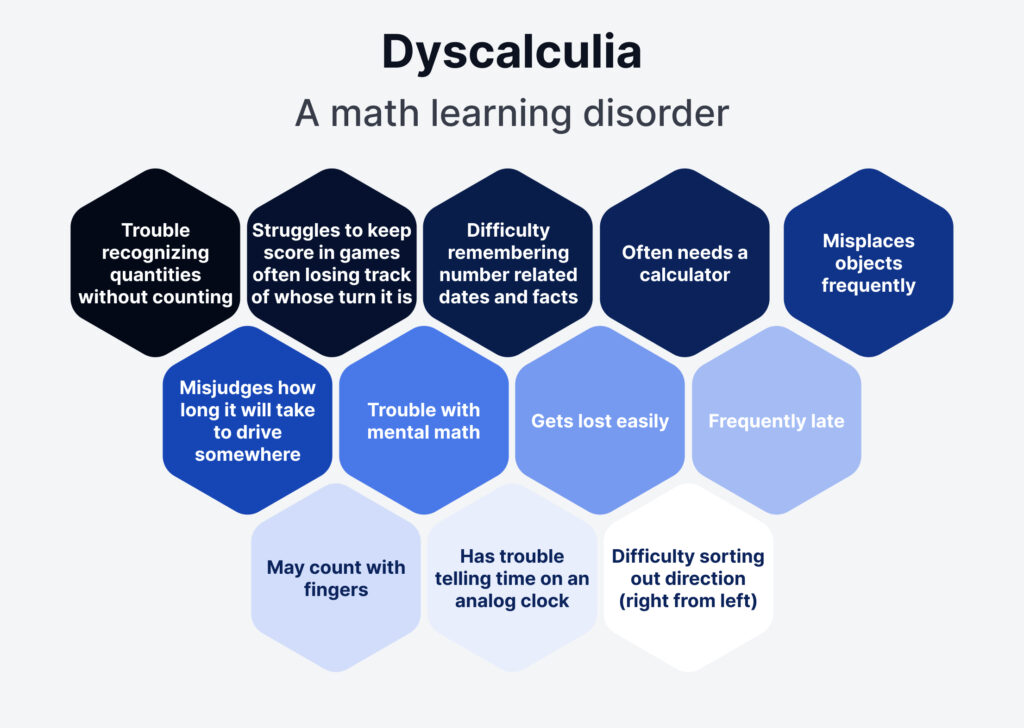Understanding Dyscalculia
Dyscalculia is a complex learning disability that extends beyond simple difficulties with math. It affects a person’s spatial reasoning, ability to grasp the concept of time, and memory for numbers, leading to challenges in everyday tasks such as handling money, measuring ingredients, or reading a clock. Recognizing the signs of dyscalculia is the first step in ensuring those affected receive the understanding and support they need to thrive academically and in daily life.

Early Identification and Intervention
Early identification of dyscalculia is critical, as it allows for timely intervention that can significantly improve a child’s mathematical understanding and related skills. Here are some key indicators to watch for in children:
- Difficulty Understanding Basic Number Concepts: Children with dyscalculia may struggle to grasp the significance of numbers, their values, and the relationships between them. Simple concepts such as ‘more than’ or ‘less than’ can be confusing.
- Challenges with Math Facts: Memorizing and recalling basic math facts, such as addition or multiplication tables, can be exceptionally hard for children with dyscalculia, affecting their speed and accuracy in calculations.
- Problems with Mathematical Reasoning: Dyscalculia can make it difficult for children to follow sequences of mathematical steps. They may have trouble understanding word problems or using logical steps to solve equations.
- Difficulty with Spatial Relationships: Spatial reasoning, crucial for geometry and understanding visual-spatial aspects of math, like graphs and charts, can be impaired in individuals with dyscalculia.
- Trouble Learning to Tell Time: Learning and understanding concepts of time, including reading clocks and grasping time management, are often challenging for those with dyscalculia.
Recognizing these signs necessitates a compassionate, patient approach, emphasizing the child’s strengths while acknowledging the areas where they need support. It’s important to remember that dyscalculia varies in severity, and not all children will exhibit all these signs.
Fostering Support and Seeking Professional Evaluation
If you suspect a child might have dyscalculia, the next step is to seek a professional evaluation. This usually involves a comprehensive assessment by a psychologist or a specialist in learning disabilities, which can provide a clear diagnosis and recommend specific interventions tailored to the child’s needs.

Strategies for Supporting Children with Dyscalculia
Supporting a child with dyscalculia involves a multi-faceted approach that includes tailored educational strategies, supportive technologies, and fostering a positive learning environment. Here are some strategies that can help:
- Use Visual Aids and Hands-On Learning: Visual aids, manipulatives, and concrete examples can help children grasp mathematical concepts more easily.
- Incorporate Technology: Various educational apps and software are designed to make learning math more interactive and engaging for children with dyscalculia.
- Adopt a Mastery-Based Learning Approach: Focus on ensuring a child fully understands a concept before moving on to the next, allowing them to learn at their own pace.
- Promote a Growth Mindset: Encourage children to see challenges as opportunities for growth and emphasize effort over innate ability.
Practical Steps for Parents to Identify and Support Dyscalculia
Parents play a pivotal role in identifying and supporting their children through the challenges of dyscalculia. At home, there are several proactive steps parents can take to not only spot signs of this learning difference but also to create a nurturing environment that can help mitigate its impact. Engaging in activities that promote numerical understanding, without the pressure of formal schooling, can provide insightful cues into a child’s mathematical abilities and struggles.
For instance, playing board games that require counting or strategic thinking, cooking together using measurements, or even shopping with a budget can highlight difficulties with numbers and calculations in real-life contexts.
When signs of dyscalculia become apparent, parents can adopt specific strategies to support their child’s learning at home. Simplifying concepts into smaller, manageable steps and using everyday examples can make abstract mathematical ideas more concrete and understandable.
Encouraging the use of tools like number lines, visual aids, or digital apps designed for learning support can also be beneficial. Moreover, fostering an open dialogue about challenges without stigma, celebrating small victories, and maintaining a positive, encouraging attitude are crucial.
This emotional and educational support can significantly boost a child’s confidence and willingness to engage with math, despite the difficulties.
In addition to these direct approaches, parents should also consider seeking guidance from professionals or support groups. Connecting with educators, therapists, or other parents who have navigated similar challenges can provide valuable advice, resources, and moral support. By taking these actions at home, parents not only aid in the early identification and understanding of dyscalculia but also contribute to building a foundation of support and confidence that empowers their child to tackle the challenges of dyscalculia head-on.
Conclusion: Embracing Differences and Empowering Learners
Identifying and supporting children with dyscalculia is a journey of understanding, patience, and persistence. By recognizing the signs early and implementing effective strategies, parents and educators can create a supportive environment that enables children with dyscalculia to unlock their potential and succeed in their academic endeavors and beyond. Embracing these differences and advocating for the necessary support can make a significant difference in the lives of children with dyscalculia, ensuring they have the resources and confidence to overcome challenges and thrive.







